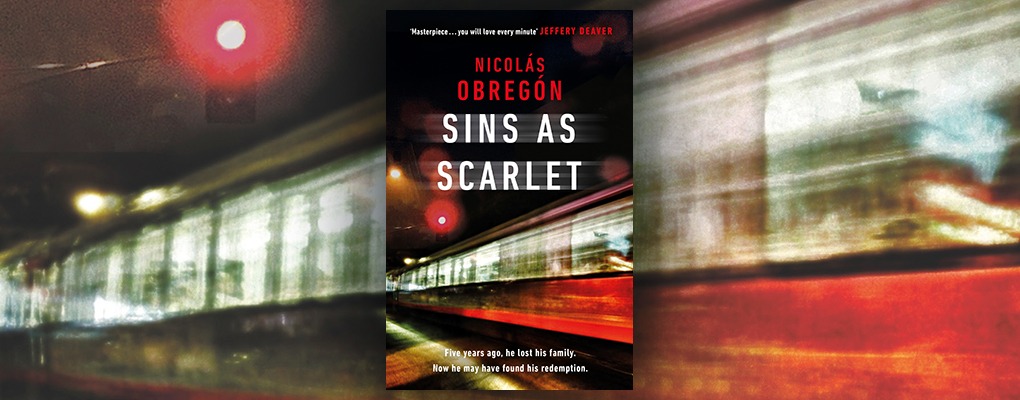Books
Sunsets & hummingbirds: the story behind Sins as Scarlet
This book began life in death. Specifically, a dead hummingbird in the pocket of a dead man, his remains found near the US border in 2009. A common indigenous symbol of safe passage, hummingbirds are considered a messenger between the living and the dead. I wondered if the man, presumably a Mexican or Central American migrant, had brought it for luck, to keep him safe during the crossing.
But I’m getting ahead of myself. I’ll step back by moving forwards in time.
In late spring of 2016, I was sitting in a café near the corner of Sunset Boulevard and Hyperion Avenue nursing my jet lag and an over-conceptualised coffee. I had just moved to Los Angeles and was scratching my head trying to decide what to do next. My first novel, Blue Light Yokohama, wasn’t even out yet but here I was trying to decide which direction to take Inspector Iwata in.
Even in his earliest conception, he was always going to have more than one story to tell. Before I had shown anyone a single word, Iwata was already swamped in sequels and prequels and short story ideas. But then I got an agent, and even more miraculously, a book deal for two Iwata novels. Somehow, there I was, beginning work on what would become Sins as Scarlet.
The only thing I was certain about was that I wanted to take Iwata out of his ‘comfort zone’ — I had no interest in him riding the wave of his success, in having power, in commanding respect. Iwata would not be Iwata if doors opened for him.
By moving him to Los Angeles, he’d be a nobody overnight. If I took away his badge, no doors would open for him, he’d have to blag or bribe his way in. Besides, the City of Angels had kindled my love of detective fiction. I grew up with my imagination submersed in its filthy kingdom of noir, the seediness, the scores, the snobbery. Through the eyes of everyone from Marlowe to Rick Deckard, I wolfed LA down, dreaming of one day writing about a detective stalking through her streets, doffing his cap to the ghosts of his predecessors as he went. Now I had my chance.
Iwata would not be Iwata if doors opened for him.
Thematically, I knew I wanted to explore two things in Sins as Scarlet: the past and identity. Iwata’s mother, Nozomi, appears briefly in Blue Light Yokohama but after so many drafts, her voice fell largely silent. Now I could burrow into who she was, where she came from, what led her to abandon her son. And by delving into her past, so too we would understand Iwata more thoroughly.
Iwata is bi-cultural with a talent for languages. Like me, he’s from two places and no places all at once. These were all things alluded to in Blue Light Yokohama. Now I wanted to dive into them headfirst. His upbringing has straddled two countries, two cultures, two languages. On the one hand he is Japanese, on the other he grew up in the United States. How would that affect him now, approaching forty, living alone in Los Angeles? Who would he be?
Of course, I’d mapped out Iwata’s backstory long before I got a book deal. I’d told myself back then that if I ever made it this far, my second Iwata book would take him back to Los Angeles and, in the undertones beneath the framework of a crime fiction novel, it would attempt to explore biculturality, alienation, generational gaps. After all, following on from the events of Blue Light Yokohama, it was logical that Iwata would want to leave Japan behind, certainly the Tokyo Metropolitan Police. Moving him to LA would bring him closer to his mother while turning him into a private investigator would also drag him down the rabbit hole again.
I believe the landscape dictates the mood of a story just as much as its events or the characters that drive it.
As a crime writer, I see setting as its own character. I believe the landscape dictates the mood of a story just as much as its events or the characters that drive it. Like Tokyo, there is an idea of Los Angeles, fed by a million movies. People believe that Angelenos live in either Bel Air mansions, or in South Central gang territory. Angelenos are either the uber-wealthy drinking Mai Tais up in the Hollywood Hills, or they’re far below, pimps and hustlers squabbling behind squalid motels on the Strip.
Indubitably, I wanted to attempt to bring these contrasts to the page. But at the same time, this city’s profound disparity constitutes just a single mask: Los Angeles wears many.
While I wanted my detective to navigate the upper crust and delve into the underworld, I also wanted him to pass through the Every Day of this city; open air markets, the industrial landscapes, people going to work, people having coffee, sitting in traffic.
In trying to find a way into Sins as Scarlet, I scoured newspapers, a list of John and Jane Does, and the LA County Coroner’s unclaimed persons page. That’s when I came across the website for the Colibrí Center and read the story of the man with the hummingbird in his pocket.
It was such a striking image, omen-like, a dead man with a dead bird, without a name, lost in the desert. Immediately I knew I wanted Iwata to be investigating a case similar to this, to be investigating a world of nameless migrants, rackets, and trespasses. I wanted him to be on the case of a man found dead in the desert with a hummingbird in his pocket.
And like tap turning on, the heart of the book gushed out. Sins as Scarlet would be a world of the vulnerable, the abused, the homeless, the addicted, the marginalised, the transgender, the undocumented, those dying in the street. I walled myself in with books about Los Angeles, the Borderlands, Mexico, the narco war. I spent days traipsing around Skid Row. I spoke to people living in tents under flyovers. I walked hundreds and hundreds of miles through the streets of LA.
Sins as Scarlet is a work of fiction, but ultimately I wanted it to be driven by the stark realities facing the vulnerable, the abused, the oppressed.
I visited Mexico and researched the migrant crossings into America. I began mentoring migrants in creative writing and we talked at length about being far away from home, starting again in America. I spoke with transgender women about their lives, their experiences. I read California’s Private Investigator Act and interviewed private investigators, asked them about the reality of a gumshoe’s day-to-day. As my research developed, Sins as Scarlet began to take shape. So too I began to learn of the reality facing migrants crossing into this country, the homeless population of Los Angeles, and transgender women of America. The data was fragmented, the true picture buried beneath somewhere in those lost, the shamed, the misgendered, the transient, the decomposing.
Sins as Scarlet is a work of fiction, but ultimately I wanted it to be driven by the stark realities facing the vulnerable, the abused, the oppressed. If they made it this far, I can only hope that readers will see it that way.
As for the dead hummingbird, it never did make it into the novel. Originally I wanted it to be the great denouement for Inspector Iwata, a moment of chilling epiphany at death’s door. I even toyed with the idea of including hummingbird in the title somehow. They say good writers borrow and great writers steal but I just couldn’t bring myself to take it out of that dead man’s pocket. So I leave it there, beyond the greedy gaze of my imagination, and pray (if it can be called praying) for his positive identification one day. That’s what Iwata now spends his days doing.
I’m writing this on Sunset Boulevard, drinking another over-conceptualised coffee at the same café where I first started plotting Sins as Scarlet two years ago — just a few blocks away from where we bid farewell to Iwata at the end of the book.
It’s a beautiful afternoon, the sky triumphantly blue. I sent my final draft to my editor a few days ago. I’m both overjoyed and heartbroken for it to be over, at once hopeful and hopeless, drunk on its absence. Above me there are street signs, Sunset intersecting with Hyperion — the father of the dawn and sunset, the death of each day.
I’ve always been an over-thinker and my imagination runs away with me but in this moment, writing the final words for the very end of this book, it feels like there’s a supertemporal circularity to things, as though years have passed and no time at all.
But like Kosuke Iwata, I know it’s time to put on my sunglasses and walk out of this joint. After all, tomorrow is another day, another case.



Please note: Moderation is enabled and may delay your comment being posted. There is no need to resubmit your comment. By posting a comment you are agreeing to the website Terms of Use.